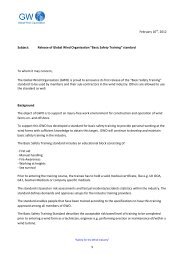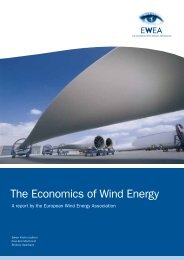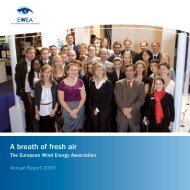Offshore Electricity Infrastructure in Europe - European Wind Energy ...
Offshore Electricity Infrastructure in Europe - European Wind Energy ...
Offshore Electricity Infrastructure in Europe - European Wind Energy ...
Create successful ePaper yourself
Turn your PDF publications into a flip-book with our unique Google optimized e-Paper software.
Key Assumptions and Scenarios<br />
Current technology. When consider<strong>in</strong>g the connection<br />
of the larger more distant offshore w<strong>in</strong>d farms, the<br />
Voltage Source Converter (VSC) HVDC technology also<br />
becomes important.<br />
Compared to High Voltage Alternat<strong>in</strong>g Current technologies<br />
and even the Current Source Converter<br />
(sometimes called L<strong>in</strong>e Commutated) HVDC technology,<br />
the VSC technology is relatively immature <strong>in</strong><br />
terms of operat<strong>in</strong>g experience. The first onshore application<br />
of VSC technology was the 50 MW Gotland<br />
l<strong>in</strong>k (Sweden) commissioned <strong>in</strong> 1999, and the first offshore<br />
application was the 84 MW Troll A l<strong>in</strong>k (Norway)<br />
commissioned <strong>in</strong> 2005. Hence this technology has yet<br />
to be proven over the expected lifetime of an offshore<br />
w<strong>in</strong>d farm or <strong>in</strong>terconnector <strong>in</strong>stallation.<br />
Despite this lack of experience, the technical advantages<br />
that the VSC equipment provides for the<br />
connection and transmission of bulk power <strong>in</strong> the<br />
offshore environment means that the VSC equipment<br />
26<br />
will be the transmission technology of choice for large,<br />
distant offshore w<strong>in</strong>d farms. It is for this reason that<br />
the majority of the offshore grid designs analysed <strong>in</strong><br />
this report is based on VSC technology.<br />
However, current experience shows that the supply<br />
cha<strong>in</strong> bottlenecks for the ma<strong>in</strong> components of HVDC<br />
technology can slow down the development of offshore<br />
w<strong>in</strong>d farm connections. Therefore for s<strong>in</strong>gular<br />
cases it might be necessary to fall back upon AC connection<br />
concepts until the supply cha<strong>in</strong> is fully able to<br />
deliver the requested equipment on time.<br />
<strong>Offshore</strong>Grid – F<strong>in</strong>al Report









